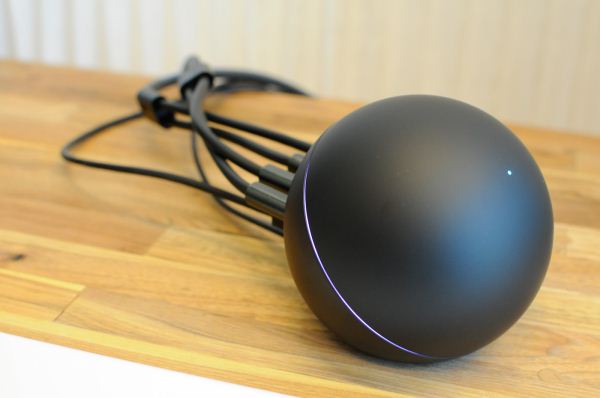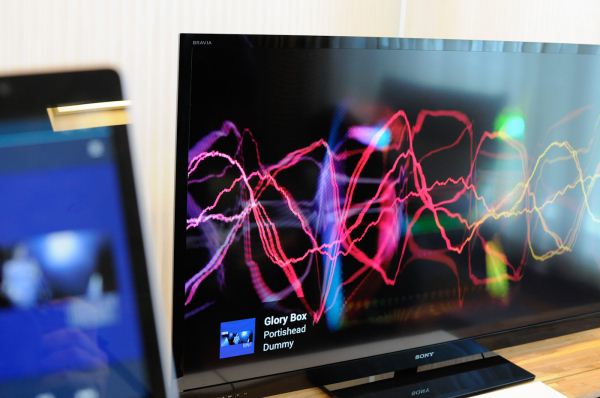Nexus Q Media Streamer - Physical Impressions
by Brian Klug on June 27, 2012 5:06 PM EST- Posted in
- Media Streamer
- Android
- Google IO
- I/O 2012
- Nexus Q
We just picked up our Nexus 7, Q, and Galaxy Nexus with 4.1 demo devices and will be publishing a piece with some impressions of the Nexus 7 and Android 4.1 shortly. Demoing the Nexus Q however is a bit challenging (and I forgot my remote to unlock the hotel TV HDMI ports), so Google had a demonstration setup of a Nexus Q with paired Nexus 7 tablets and all the functionality exposed.
I have to admit I was originally a bit uncertain about what functionality the Nexus Q would deliver and how it fits in with Google TV, but all makes sense now. The device is really an accessory to everything visual and audio under the Google Play umbrella. That means Google Play Music, Movies, YouTube, and so on can be played back through the Nexus Q to an attached TV or A/V Receiver. If you're the visual type, just watch the video and all will be explained. If not, read on.
The Nexus Q has outputs on the back for Optical TOSlink, 5.1 audio banana plugs, microHDMI, microUSB, and 10/100 Ethernet. The Nexus Q can again be used either in an audio-only mode as a music sink, or for audio and video. Inside is the same OMAP4460 SoC that's in the Galaxy Nexus, along with 1 GB of RAM, dual band (2.4 and 5 GHz) single spatial stream WiFi, Bluetooth, and NFC. The top portion of the Nexus Q rotates, controlling audio playback volume. Tapping on the center pauses media playback.
Nexus Q attaches to your WiFi network, and streams music or video in your Play Store account from the cloud. Media gets downloaded directly to the Nexus Q and sits in that 16 GB of storage in a 24 hour cache. There's no file system to manage or worry about, however. Users can tap their NFC-enabled devices to the Nexus Q and download the Nexus Q Settings application, as well as update their installed Play Store applications to be compatible - there's no ICS requirement for client devices, you just need to be able to run the newest Play Store Music and Movies applications.
The control application lets you perform initial setup (which happens over Bluetooth), as well as control what outputs are to be used on the Nexus Q for video and audio. There's also control over the music visualization, LED color theme, and brightness. Multiple Nexus Q endpoints can be setup and will automatically light up with different colors as well as populate drop downs.
What's different about Nexus Q from, say, Apple TV, is that media isn't transcoded and sent over to the playback device, but instead played back from the Nexus Q directly. That way, users can leave the WiFi network and media will continue playing back. Friends with purchased media can also playback that content without any setup at all.
Multiple clients can attach and add to a queue on the device, adding music that's either in their account or purchased. There's no credential system setup, however, so anyone on your network can change and control the playback queue. To some extent if you're privileged enough to be given a friend's WiFi PSK you probably can be trusted to not maliciously playback indecent YouTube videos or clear the queue, but I still think playback credentials would make sense.
There's no current support for playing back content from other sources, like say Netflix. This is really a sink for audio and video from the Android ecosystem at this point, though it seems like adding other streaming functionality is another logical step. During the keynote the presence of microUSB was mentioned for hackability. It's obvious Google envisions the Nexus Q as something of an Apple TV or Airport Express (audio playback) accessory to its media stores. I also asked where the Nexus Q sits compared to Google TV and got the impression Google views the two as largely orthogonal, with no intention to have the Nexus Q replace Google TV, or for Google TV to inherit some of the Nexus Q features (which seems like a logical next step).
The rest of the details are pretty basic - the Q supports output at 1080p30 in addition to 720p and other basic resolutions you'd expect over HDMI. The Nexus Q is already up for pre-order at a price of $299 and will ship mid July.


















28 Comments
View All Comments
mevans336 - Wednesday, June 27, 2012 - link
I have to agree. The AppleTV is almost as capable and sells for $99.What I don't see is any mention of local playback capability. With my AppleTV (v3) I have to convert everything to MP4 with AC3. However I can do that and then import to iTunes, then stream to my AppleTV without issue.
Can this thing even play back anything local since Google Play cloud based?
GrizzledYoungMan - Wednesday, June 27, 2012 - link
That's what I'm wondering. Personally, I went with the WDTV gen 3 SMP over the latest gen ATV, largely for the uniquely comprehensive local content playback capabilities. I was pleasantly surprised to find that it did a beautiful job with Netflix, Vudu and Hulu, too. All for about $90.By comparison, paying $300 for the privilege of playing out content from yet another audio video service, this time one that I don't use because it sucks? No thanks.
mevans336 - Wednesday, June 27, 2012 - link
Looks like ExtremeTech answered our question. No local playback capability.http://www.extremetech.com/electronics/131857-nexu...
"On the other hand, being dependent on the cloud for media is going to hold the Nexus Q back from its potential. While the Google Play Store is nice — and is where Google makes money selling media — it generally does not integrate personal media. The one exception seems to be music in that Google Play Music will stream tracks that you have uploaded to Google even if you did not buy them from Google itself. Movies are still very much locked to only those on Google Play which means no DVD or Blu-ray rips. It also means that you are not able to share personally recorded videos. Even if they are sitting on your Android phone, you will not be able to play them back on the Nexus Q — at least not yet."
While some of the Q features are awesome ... for $299? I'm seriously laughing. You could build a Brazos platform for about that much and get much more functionality. (If you're technical.)
GrizzledYoungMan - Wednesday, June 27, 2012 - link
Out of curiosity - and I'm not even being sarcastic here - what features does it have that impress you? Seems like the only stand out to me is the depth of control it offers from an Android device, but since both the WDTV and ATV options have pretty rich Android/iOS apps, that's a non-starter. Hell, controlling volume from the source isn't even a good idea, and usually compromises audio quality.Penti - Wednesday, June 27, 2012 - link
AppleTV supports Airplay, does this thing support WiFi Direct or Intel WiDi or even DLNA? Probably not. If not it's certainly more useless then an AppleTV.I couldn't care less about Google Play services as a Swede the only thing we have and will get is the market so the branding is borked to begin with. They will never acquire the viewing rights for any major European nation either for any of their other services. They simply won't be here and I don't need a 300 dollar device to view youtube. The best we can do here is Flash Player streaming-content basically. And warez. But I suspect other solutions will be better for warez.
If Google continues to build their own US only services and thinks Android is a way to promote those they will eventually fail in other markets and be forked or something.
Penti - Wednesday, June 27, 2012 - link
Apple is going global on the other hand, they understand they need to say support local Chinese services, localization and so on. You can even buy apps in Zimbabwe now. Google seems to be going backwards or at least schizophrenic. Not that they will be displaced by Windows Phone or anything. Maintaining one persona must be easier though. You can't win on your services if they won't be available. Partners might not really want Googles new branding, but they need Google's Market. Or they might as well fork it as some Chinese vendors continues doing. As a media hub their device certainly fails by only being tied in into their own services and not extended by APIs that third parties can use. It's pretty much even designed to fail. At least the AppleTV is cheap even if using it only for Airplay. This device basically can't be used at all outside the US.Impulses - Wednesday, June 27, 2012 - link
It should be $200 tops, nothing in that thing justifies a $300 price point unless the Nexus 7 is being sold at a loss... Even at $200 it'd be a tough sale tho. Why on earth is this functionality not being baked into Google TV devices? They couldn't get hardware partners to agree to a couple extra requirements? This was just someone's project? It seems even more doomed than GoogleTV, which had a ton of potential (being let down by price and lack of content partnerships).mcnabney - Wednesday, June 27, 2012 - link
It is almost as capable as my ION-based HTPC that I bought/upgraded three years ago for $250.Except this thing has no local storage.
Or can tune-in media.
Or can be remotely accessed.
Or can use Netflix, Hulu and other streaming sites.
Or even play casual games.
Or support fully featured wireless mice/keyboards.
Why would anyone buy this thing again? About the only thing novel about it is the direct speaker connection, access to Google Play, and the queuing function.
fteoath64 - Sunday, July 1, 2012 - link
"Why would anyone buy this thing again?"Oh, I know. A crazy rich audiophile who lack tech knowledge and wanted to connect the TOS link cable to his DAC and high priced stereo. That sourcing low-bit rate content from the cloud ?!. If the content is anything less than 320K bit-rate, a TOS link is really not doing anything to the music. And his friends like to queue a lot of loud music which really spoils the quality of the system.
dananski - Wednesday, June 27, 2012 - link
I don't know about anyone else but it takes me about a day or two to download a bluray-sized file from a site with decent server bandwidth - and no one else can do big downloads / play online / make a Skype call at the same time. How are they expecting people to stream HD video content in real time from the cloud? Or did he mean from a fileserver?